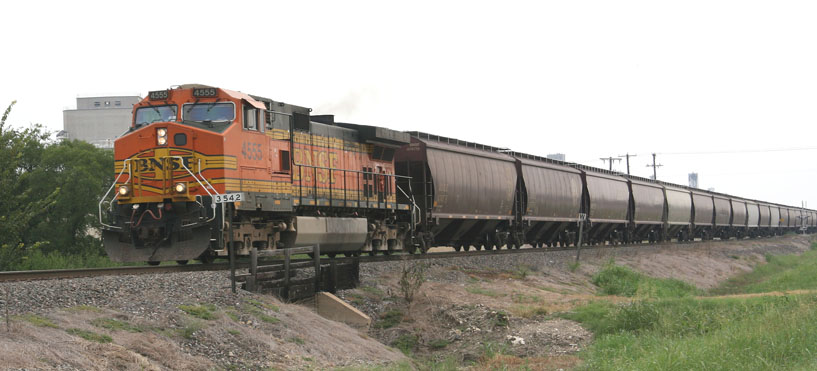All about the community of model railroading and rail enthusiasm
September 1, 2014

Farmers and shippers are expecting a record grain crop in 2014 and have voiced concern over the ability of North American railroads to handle additional volumes. BNSF Railway (above) and Canadian Pacific have recently reported a backlog of cars available to meet shipping requests. – Cowcatcher Magazine
BNSF Railway and Canadian Pacific have reported backlogs of almost 2,400 cars between them, according to published reports. Both railroads maintain that oil shipments have not replaced crop shipments but farmers and shippers are applying pressure in an attempt to get product to market.
On Thursday, the U.S. Surface Transportation Board will hold a public hearing in Fargo, ND, where farmers and shippers can voice concern. CP and BNSF representatives are expected to attend.
While oil production from the Bakken Shale in North Dakota and other U.S. North American oil plays have commanded significant track time, America’s grain belt has been churning at a record pace. The U.S. Dept. of Agriculture said that total inspections of grain (corn, wheat, and soybeans) from all major export regions reached for the week ending Aug. 21 were up 51 percent from last year and 22 percent above the three-year average. Total inspections were 1.81 million metric tons, an 11 percent increase from the previous week.
This year’s U.S. wheat harvest is expected to be a record 273 million bushels, up from 235 bushels in 2013. Record amounts of soybeans are expected, as well as a significant increase in corn production.
However, opportunities are being lost because product can’t get to market fast enough.
In May, a North Dakota State University study concluded that North Dakota farmers have lost nearly $67 million this year because of rail shipment delays, and could lose an additional $95 million if the delays persist.
North Dakota farmers rely on rail transportation to move its top major crops of wheat, corn, and soybeans. They know their produce is kept safe and compact in bulk bags and that the transportation via trains is smooth and quick.
The study reported that increased oil transportation contributed to delayed grain deliveries and increased costs in transportation. An extremely cold winter and high demand for grain shipments also contributed.
Petroleum and petroleum-related shipments have been on the rise, but so have other commodities.
The Association of American Railroads (AAR) reported last week that total combined U.S. traffic for the first 34 weeks of 2014 was 18,557,471 carloads and intermodal units, up 4.6 percent from last year. For the week ending Aug. 23, carloads were up 3 percent compared to the same time last year.
Eight of 10 of the carload commodity groups posted increases compared with the same week in 2013, including petroleum and petroleum products with 16,396 carloads (up 28.4 percent) and grain with 18,721 carloads (up 17.6 percent). Nonmetallic minerals were up 10.5 percent.
Canadian railroads have posted similar increases in rail traffic.
Average terminal dwell time per hour per car, however, is on the rise, indicating that car movement across U.S. and Canadian rail systems is slower. Of six Class Is voluntarily reporting dwell time to the AAR, all posted higher times in July 2014 compared to the second quarter of 2013. BNSF and CSX topped the charts, each averaging five additional hours.
But railroads are making an effort to meet demand by the farm, even if it means stepping back from the oil patch so who knows what the future will look like, it might be the time to learn how to invest in oil, who knows anymore.
In August, OmniTRAX Canada announced it would suspend plans to ship crude oil for the foreseeable future to accommodate large grain contracts.
President Merv Tweed said that consultations with First Nations, Metis and the provincial government were important factors in the company’s decision to suspend shipping crude by rail.
“Our decision to suspend crude by rail was based in part that grain shippers were willing to commit long-term orders in contracts of over 700,000 metric tons due to the market’s overall growth,” Tweed said in a news release. “Following last year’s record crop, we’re preparing for another strong shipping season.”
The railroad group also said it would continue to diversify its product mix through the Port of Churchill to include potash, feed and wood pellets.
“After reviewing our current business operations, we are also developing a long-term sustainability strategy that will make policy recommendations to the Provincial and Federal Governments, as well as identifying critical infrastructure investments required to continue the development of the Northern Gateway trade corridor,” said Tweed.
The Port of Churchill handled over 600,000 metric tons of grain in 2013; almost 10 million liters of petroleum products; building and construction materials as well as dry goods, vehicles and equipment and a variety of products for mining companies, communities and individuals.